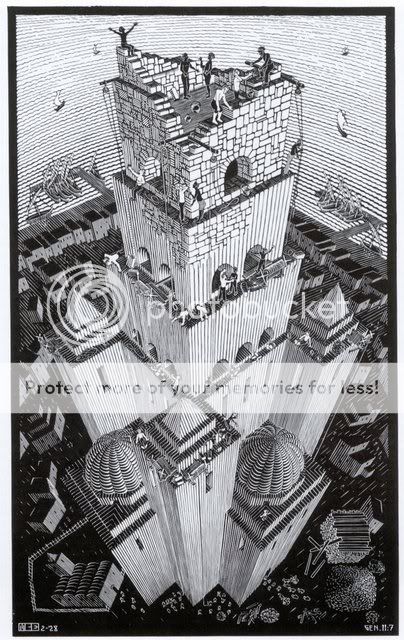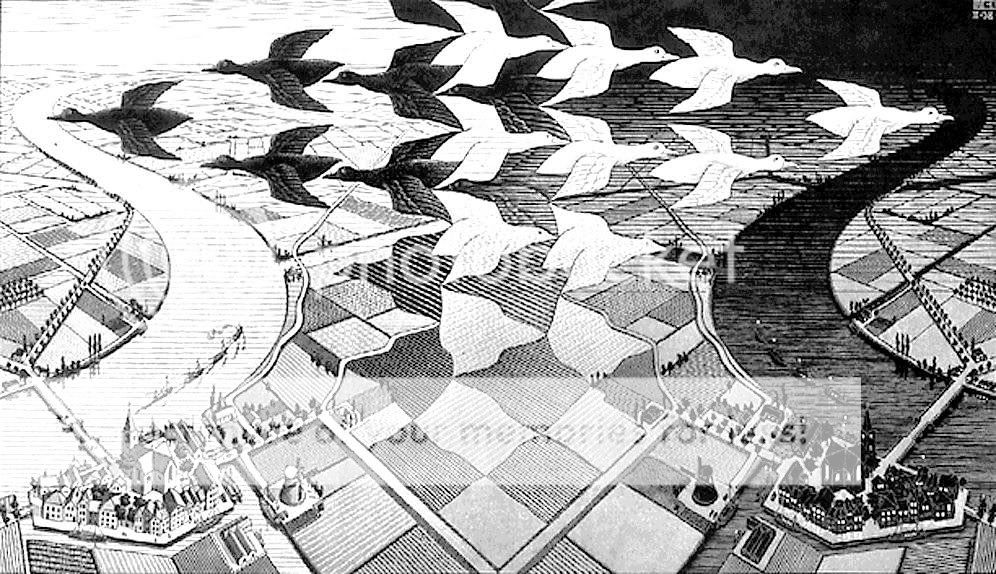Art Sunday 04/27/08: M.C. Escher
Eye by M.C. Escher
The Dutch artist Maurits C. Escher (1898-1972) was a draftsman, book illustrator, tapestry designer, and muralist, but his primary work was as a printmaker. Born in Leeuwarden, Holland, the son of a civil engineer, Escher spent most of his childhood in Arnhem. Aspiring to be an architect, Escher enrolled in the School for Architecture and Decorative Arts in Haarlem. While studying there from 1919 to 1922, his emphasis shifted from architecture to drawing and printmaking upon the encouragement of his teacher Samuel Jessurun de Mesquita. In 1924 Escher married Jetta Umiker, and the couple settled in Rome to raise a family. They resided in Italy until 1935, when growing political turmoil forced them to move first to Switzerland, then to Belgium. In 1941, with World War II under way and German troops occupying Brussels, Escher returned to Holland and settled in Baarn, where he lived and worked until shortly before his death.

Relativity by Escher
The main subjects of Escher’s early art are Rome and the Italian countryside. While living in Italy from 1922 to 1935, he spent the spring and summer months traveling throughout the country to make drawings. Later, in his studio in Rome, Escher developed these into prints. Whether depicting the winding roads of the Italian countryside, the dense architecture of small hillside towns, or details of massive buildings in Rome, Escher often created enigmatic spatial effects by combining various — often conflicting — vantage points, for instance, looking up and down at the same time. He frequently made such effects more dramatic through his treatment of light, using vivid contrasts of black and white.

Tower of Babel by M.C. Escher
After Escher left Italy in 1935, his interest shifted from landscape to something he described as “mental imagery,” often based on theoretical premises. This was prompted in part by a second visit in 1936 to the fourteenth-century palace of the Alhambra in Granada, Spain. The lavish tile work adorning the Moorish architecture suggested new directions in the use of color and the flattened patterning of interlocking forms. Replacing the abstract patterns of Moorish tiles with recognizable figures, in the late 1930s Escher developed “the regular division of the plane.” The artist also used this concept in creating his Metamorphosis prints. Starting in the 1920s, the idea of “metamorphosis” — one shape or object turning into something completely different — became one of Escher’s favorite themes. After 1935, Escher also increasingly explored complex architectural mazes involving perspectival games and the representation of impossible spaces.

Reptiles by M.C. Escher

Hand with Globe by M.C. Escher

Drawing Hands by M.C. Escher

Day and Night by M.C. Escher
|
jayaramanms wrote on Apr 26, ’08
Escher’s mind-bending drawings explore perspective, mirror images and physical space. Two of his best-known prints,’ Relativity’ and ‘Ascending and Descending’, feature staircases which seem to defy gravity and run in impossible directions. His most popular work ‘Hand With Reflecting Sphere’, an image of himself as seen in a globe held in his outstretched hand. You have brought his wonderful drawings. and thank you for the same.
For Art Sunday this week, for a change I have brought the paintings of indian painter Raja Ravi Varma at – http://jayaramanms.multiply.com/journal/item/138/TRIBUTE_TO_RAJA_RAVI_VARMA and album at – http://tinyurl.com/3uxc2y or http://jayaramanms.multiply.com/photos/album/12/PAINTINGS_OF_RAJA_RAVI_VARMA. Please see. |
|
lauritasita wrote on Apr 26, ’08
This is the kind of art that really makes you think.
|
|
lauritasita wrote on Apr 26, ’08
I could stare at his stuff for hours.
|
|
starfishred wrote on Apr 27, ’08
He was very very good thanks
|
|
wickedlyinnocent wrote on Apr 27, ’08
Escher’s perspectives, levels, a master of illusion, thanks for the great blog, Laurita.
|
|
asolotraveler wrote on Apr 27, ’08
the subject of others’ past posts but never so big and bold as yours today! bravo
|
|
lauritasita wrote on Apr 27, ’08
asolo, it’s all in the presentation ! Thanks so much for your comments.
|
|
philsgal7759 wrote on Apr 27, ’08
I have always enjoyed this artist Thanks
|
|
lauritasita wrote on Apr 27, ’08
He’s so interesting, isn’t he ?
|


Comments
Art Sunday 04/27/08: M.C. Escher — No Comments
HTML tags allowed in your comment: <a href="" title=""> <abbr title=""> <acronym title=""> <b> <blockquote cite=""> <cite> <code> <del datetime=""> <em> <i> <q cite=""> <s> <strike> <strong>